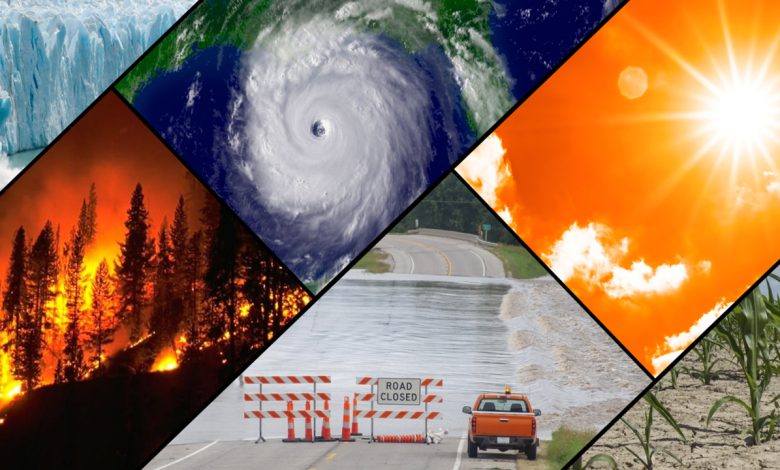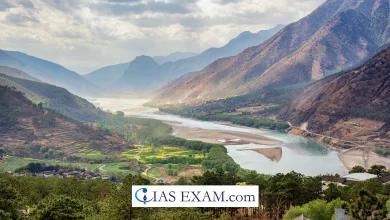Daily Current Affairs for UPSC
The effects of Climate Change on the Indian economy
Syllabus- Indian Economy [GS Paper-3]

Context- As part of the G20 meetings, the MIDS and the Reserve Bank of India organized the discussion on the effects of climate change on the Indian economy.
Impacts of Climate Change on the Indian Economy
- Lower Yield on Crops: Weather patterns may become less predictable as the climate changes. Farmers’ decisions regarding which crops to plant and when to plant them are impacted by uncertainty regarding monsoonal changes, which in turn reduces productivity.
- Additionally, dwindling glaciers and earlier seasonal snowmelt will reduce irrigation-related river flow.
- Effects on Animals: Animals are used as household capital, particularly in landless households, and as milk producers, manure, and seeding in India’s largest livestock population.
- Feed and fodder are less available under heat stress, and disease-promoting conditions are worsened.
- Workforce with fewer workers: On days with extreme heat, workers’ productivity tends to be lower, which lowers industrial yields, decreases exports, lowers national income, and indirectly affects global trade.
- In industries like construction that rely heavily on outdoor activity, climate change reduces cognitive performance and work hours.
- Energy shortage: The International Energy Agency (IEA) predicts that India’s primary energy consumption will double by 2030.
- Climate and energy have a unique relationship, which means that as temperatures rise, more energy needs to be used to reduce heat effects.
- Additionally, climate change policies frequently clash with rising energy demands.
- Effect on the Structure: A nation’s economy greatly benefits from a sound infrastructure. The infrastructure has been severely impacted by climate change’s increase in extreme natural disasters.
- For instance, India’s flood-related economic losses in the past ten years totaled $3 billion, or 10% of the global total.
- Around 13 million people in India were affected by cyclone Amphan in 2020.
- Effect on the System of Drainage: India uses the Indo-Gangetic Plain as its “breadbasket” and takes 34% of the water it has available each year.
- Himalayan glaciers are melting at an ever-increasing rate as a result of rising temperatures and increasing seasonal variability.
- If the rate goes up, glacial lakes will burst their natural limits, leading to flooding in river valleys fed by these glaciers and decreased flows that will cause a lack of water.
- Increasing Inequality: In India, adaptability varies by state, location, and socioeconomic status.
- Because they are directly impacted by rising cereal prices and decreasing agricultural wages, low-income families are more susceptible to economic losses caused by climate change.
- As a result, adapting to climate change may result in reduced economic growth and tighter budgets for those whose resources are limited.
Way Forward
- Mitigation:
- Solutions based on nature: The development of green and clean energy can reduce air pollution and shift the burden of fossil fuels.
- Additionally, there may be a surge in employment if new transit systems are constructed or existing ones are extended.
- India’s Nationally Determined Contribution (NDC) report targets 40 percent clean energy generation by 2030.
- Environmentally friendly procedures: Environment and economy go hand in hand. To effectively address the challenges posed by climate change, a planned approach to development that guarantees uninterrupted growth prospects—especially for the rural economy in India—is required.
- Additionally, climate change presents an opportunity to develop in a cautious but sustainable manner.
- Conservation of Wetlands and Forests: Rainfall and temperature regulation are well-known functions of forests.
- Preservation and upgrade of woodlands and wetlands will uphold horticultural efficiency, sequester CO2 emanations, and improve versatility to ecological shocks as Forefront Heroes.
- Proper disposal of waste: By adding a variety of pollutants to the atmosphere, improper waste management contributes to climate change.
- This issue will be addressed by the establishment of waste-selective management plants like waste gasification.
- Both skilled and unskilled laborers will have access to new employment opportunities as a result of the construction of these plants’ infrastructure and subsequent maintenance.
- Adaptation: The significance of planned adaptation in developing adaptive capacity is assumed.
- Techniques for Passive Cooling: Passive cooling technology is a viable alternative for reducing urban heat islands in residential and commercial buildings.
- The ancient Indian building designs cited in the Intergovernmental Panel on Climate Change (IPCC) report made use of this technology, which could be utilized in contemporary facilities.
- Better Methods of Farming: Climate change challenges can be addressed through crop diversification, irrigation-based farming, which reduces reliance on rainfall, and other practices.
- A resilient infrastructure to disasters: Shelter houses, coastal embankments, and the construction of flood-resistant roads are all examples of disaster-resistant infrastructure.
- Additionally, it is essential to develop weather forecasts and early warning systems that are more precise and timely.





.png)



